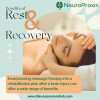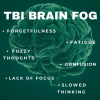Aging in Place and Brain Injury, A Convergence of Disabilities
CHRISTINE BARANDA WEAVER, MAS, OTR/L, CLCP, CBIS
Aging represents the accumulation of changes over time encompassing physical, psychological, and social changes. It is the greatest known risk factor for most human diseases.
According to the Population Reference Bureau report in January 2016, the number of Americans ages 65 and older is projected to more than double from 46 million today to over 98 million by 2060, and the 65-and-older age group’s share of the total population will rise to nearly 24 percent from 15 percent. This is due to an increase in the average U.S. life expectancy from 68 years in 1950 to 79 years in 2017, in large part due to the reduction in mortality at older ages. By 2030, the number of Americans age 65 and over has been projected to reach about 71.5 million, nearly 10 million of whom will be 85 and up.
One-third of American households are home to one or more residents 60 years of age or older.
Not only are people living longer, but recent research has also shown that most adults would prefer to age in place—that is, remain in their home of choice as long as possible. 90 percent of adults over the age of 65 reports that they would prefer to stay in their current residence as they age.
The U.S. Centers for Disease Control and Prevention (CDC) defines aging in place as “the ability to live in one’s own home and community safely, independently, and comfortably, regardless of age, income, or ability level”. The act of aging in place takes place during a period in an elderly person’s life where they can have the things that they need in their daily life while maintaining their quality of life. However, traumatic brain injury (TBI) is a significant problem in older adults. In persons aged 65 and older, TBI is responsible for more than 80,000 emergency department visits each year; three-quarters of these visits result in hospitalization as a result of the injury. Adults aged 75 and older have the highest rates of TBI-related hospitalization and death. Falls are the leading cause of TBI for older adults (51%), The age-adjusted rate of hospitalization for non-fatal TBI in the general population is 60.6 per 100,000 population; for adults aged 65 and older, this rate more than doubles—to 155.9.
The Centers for Disease Control and Prevention has termed traumatic brain injury (TBI) the “silent epidemic,” and within this silent epidemic, there is a seemingly silent population: older adults with TBI. However, there is little information available regarding the effects of the natural aging process on individuals with traumatic brain injury (TBI) as multiple variables are at play: age of injury, premorbid functioning, health status, post-injury rehabilitation, and recovery. Further work is needed to determine the best measure of outcome(s) after TBI in elder adults. As the elderly population demonstrates slower rates of functional change after recovery from TBI, this is an important consideration in future interventions.
Per CDC, elders have difficulties with everyday functioning due to:
- Motor functioning: In a 2002 study by Min Soo Kang, it was reported that of the elder population in America, 18% will have a disability. This calculates that 51 million Americans have difficulties functioning every day. 32% over age 65 will have difficulty walking, which may require the use of walkers, wheelchairs, and canes. To make life easier for the elder, some modifications that can aid them are wider entrances, grab rails, elevator chairs on stairs, etc.
- Fine motor functioning: Elders may have difficulty using their fingers, which can be problematic. As a result, modifications to handles, bathroom fixtures, etc. can aid with this problem.
- Cognitive functioning: It was reported in Kochera (2002) that 1 out of 5 people over the age of 55 will have a mental health disorder. Due to the deterioration, the five senses and cognitive capability decrease and cause slower responses. As a result, fire hazards may not be noticed, which can be very important when setting up fire alarms, exits, etc.
Given the overview of normal aging and its similarities to the common disorders sustained after a TBI, it can be reasonable to expect the same course of change in all areas of independence that’s observed in the neurotypical level of the elderly population. If so, effective measures are key components of any response to the potentially overwhelming problem of aging and aging with brain injury with a focus on prevention and neurocognitive function preservation as goals to already existing or planned efforts are appropriate and necessary.
It is recognized that the potential protective roles of psychosocial factors (e.g., higher education, regular exercise, healthy diet, intellectually challenging leisure activities, and an active socially integrated lifestyle) in the pathogenic process and clinical manifestation of aging and brain injury. With a growing number of elder adults living independently, it’s increasingly important to make sure that they’re safe at home. Falls, burns, and poisonings are among the most common accidents involving older people. The following are suggested prevention techniques to keep the environment safe:
- Keep emergency numbers handy (911, poison control, family member, healthcare provider contact information)
- Prevent falls (take a special falls risk assessment, use adaptive equipment, buy a special bracelet or necklace alarm, carry a cellphone, etc.)
- Safety proof your home (well-lit rooms, use rails, get rid of clutter, tape rugs down, remove all scatter rugs, repair frayed carpet)
- Avoid bathroom hazards (set thermostat heater no higher than 120 degrees Fahrenheit, install grab bars, put rubber mats or non-skid mats in the tub, or use a bath bench)
- Prevent Poisoning (Install a carbon monoxide detector near all bedrooms and check battery twice a year; keep medications in their original container, request large prints on your medication containers, take medications in a well-lit room, and take your medications to your provider to ensure you are taking them correctly; never mix bleach, ammonia and cleaning liquids as it when mixed, cleaning liquids can create deadly gases.)
- Protect against abuse (Keep your windows and doors locked at all times, never let a stranger into your home when you’re alone, talk over offers made by telephone salespeople with a family member or friend, always ask for written information about any offers, prizes, or charities and wait to respond until you have reviewed the information thoroughly.
- Arrange furniture to allow for adequate space for safe ambulation between and within rooms.
- When using oxygen, do not smoke or use open flames.
- Do not overload circuits and unplug appliances when not in use.
- Wear close-fitting sleeves to prevent spills and burns that could happen with loose, long sleeves.
- Do not stand on chairs and stools.
- Keep frequently used items within reach.
- Clean up spills immediately.
- Keep closet doors and drawers closed to prevent tripping or bruising.
- Keep electrical wires bound together and tucked away to prevent tripping.
- Break tasks into smaller steps and carry/transport one (1) item at a time to allow one free hand for stability.
Optimal physical and cognitive function is vital to independence, productivity, and quality of life of the elderly and ones aging with a brain injury.



